The Liquid-Tight Flexible Non-Metallic Conduit Market is estimated to be valued at USD 585.3 billion in 2025 and is projected to reach USD 1263.6 billion by 2035, registering a compound annual growth rate (CAGR) of 8.0% over the forecast period. This steady trajectory highlights growing adoption in residential, commercial, and industrial applications where moisture-resistant and flexible wiring solutions are essential. From 2020 to 2025, the market expanded from USD 398.3 billion to USD 585.3 billion, showing consistent year-over-year (YoY) growth of 6–9% driven by increasing construction activity, rising safety standards, and demand for lightweight conduit alternatives. By 2026, the market is expected to reach USD 632.1 billion, with YoY growth exceeding 8% as urbanization and smart building initiatives fuel installations.
Between 2027 and 2030, values are projected to grow from USD 682.7 billion to USD 796.3 billion, reflecting strong adoption across data centers and manufacturing facilities. The period 2030–2035 represents accelerated adoption, with the market scaling from USD 796.3 billion in 2030 to USD 1,263.6 billion by 2035. During this stage, YoY growth remains stable at 7–9%, supported by increased infrastructure modernization, renewable energy projects, and compliance with stringent wiring regulations. The sustained upward curve underlines how liquid-tight flexible non-metallic conduits are becoming indispensable to modern infrastructure.

| Metric | Value |
|---|---|
| Liquid-Tight Flexible Non-Metallic Conduit Market Estimated Value in (2025 E) | USD 585.3 billion |
| Liquid-Tight Flexible Non-Metallic Conduit Market Forecast Value in (2035 F) | USD 1263.6 billion |
| Forecast CAGR (2025 to 2035) | 8.0% |
The liquid tight flexible non metallic conduit market is gaining momentum due to the increasing need for safe and reliable cable protection in harsh and moisture prone environments. Urban infrastructure development and growing demand for flexible wiring solutions in confined or mobile installations are reinforcing market growth.
These conduits are widely favored for their corrosion resistance, lightweight structure, and ease of installation, making them ideal for both new construction and retrofitting applications. Enhanced fire retardant and UV-resistant properties have extended their usage across a variety of environments, including railways, residential, and commercial sectors.
As modern infrastructure projects demand high-performance cable management systems that adhere to safety codes while simplifying installation, the market is poised for steady expansion across both developed and emerging economies.
The liquid-tight, flexible, non-metallic conduit market is segmented by trade size, application, end use, and geographic region. By trade size, the liquid-tight flexible non-metallic conduit market is divided into ½ to 1, 1¼ to 2, 2½ to 3, 3 to 4, 5 to 6, and Others.
In terms of application, the liquid-tight flexible non-metallic conduit market is classified into Rail infrastructure, Military aerospace, Healthcare facilities, Process plants, Energy, and Others. The end-use market for liquid-tight, flexible, non-metallic conduit is segmented into Residential, Commercial, Industrial, and Utility. Regionally, the liquid-tight flexible non-metallic conduit industry is classified into North America, Latin America, Western Europe, Eastern Europe, Balkan & Baltic Countries, Russia & Belarus, Central Asia, East Asia, South Asia & Pacific, and the Middle East & Africa.

The ½ to 1 trade size segment is anticipated to account for 36.20% of total market revenue by 2025, positioning it as the leading trade size category. Its dominance can be attributed to its versatility and compatibility with a wide range of low to medium voltage electrical applications.
The ease of bending and routing makes this size ideal for tight or constrained installations, particularly in residential and light commercial settings. Additionally, the reduced material cost and lower weight contribute to easier handling and reduced labor requirements.
Its extensive adoption across multiple sectors reflects its optimal balance between performance, flexibility, and cost efficiency, securing its position as the most preferred trade size in the market.
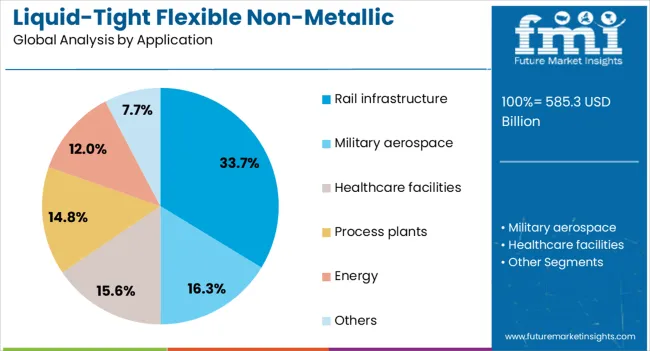
The rail infrastructure segment is projected to hold 33.70% of total revenue by 2025 within the application category, marking it as the dominant usage area. This growth is being supported by increasing investments in transportation modernization, particularly electrification and signaling upgrades.
Liquid tight flexible non metallic conduits are preferred in rail environments due to their resistance to vibration, moisture, and corrosive elements. These attributes ensure sustained protection of cabling systems across tunnels, platforms, and rolling stock.
With rising global emphasis on rail safety and operational reliability, demand for rugged yet flexible conduit systems continues to increase, reinforcing the leadership of this application segment.
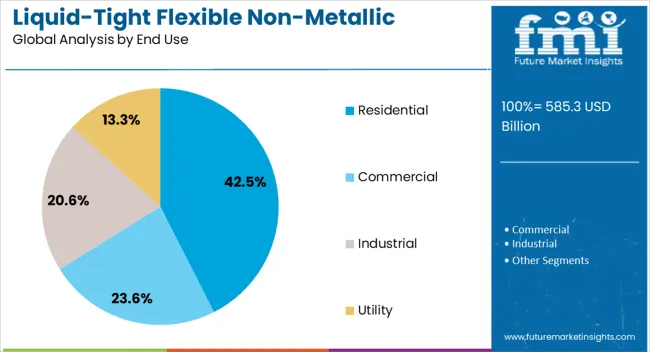
The residential segment is expected to contribute 42.50% of the market revenue by 2025 under the end use category, making it the most significant user base. The dominance of this segment is driven by sustained housing construction, renovation trends, and growing electrical safety awareness.
These conduits are widely used in kitchens, basements, and outdoor installations where water resistance and flexibility are required. Their ease of installation, along with compliance with residential building codes, supports widespread preference among contractors and builders.
As smart home integration and renewable energy installations expand, the use of liquid-tight flexible non-metallic conduits in residential settings is expected to remain strong, anchoring its leadership in the end-use category.
The liquid-tight flexible non-metallic conduit (LFNC) market is experiencing steady growth due to rising demand for reliable cable protection in industrial, commercial, and residential applications. These conduits are valued for their corrosion resistance, flexibility, lightweight properties, and ease of installation. Growth is supported by increasing infrastructure development, electrical safety requirements, and expansion in renewable energy and telecommunication projects. North America and Europe drive adoption with strong building codes and electrical standards, while Asia-Pacific shows significant growth from industrial expansion. Market differentiation focuses on flame-retardant formulations, UV resistance, and compatibility with diverse wiring systems.
LFNC performance depends heavily on material quality and durability. Variations in PVC compounds, plasticizers, and coatings can affect resistance to UV exposure, chemicals, and mechanical stress. Inconsistent formulations may result in cracking, brittleness, or reduced flexibility under extreme conditions. Manufacturers must meet strict performance specifications to ensure conduit reliability across environments such as outdoor installations, industrial plants, and hazardous locations. Until harmonized global standards for testing and durability are established, maintaining consistent quality remains a challenge, impacting market trust and widespread adoption.
Innovation is enhancing LFNC performance and expanding applications. Advances include halogen-free flame-retardant materials, improved UV and oil resistance, and enhanced flexibility for easier installation in confined spaces. Smart conduit designs with embedded sensors for monitoring temperature and strain are emerging for advanced industrial settings. Lightweight, eco-friendly formulations reduce environmental impact while maintaining compliance with fire and safety codes. These innovations strengthen adoption in renewable energy, data centers, and commercial projects, positioning technologically advanced products as premium solutions in the market.
The LFNC market is shaped by diverse electrical codes and safety standards, including NEC (National Electrical Code), IEC, and regional building regulations. Compliance ensures safety in wiring protection, fire resistance, and environmental suitability. However, different approval requirements across countries complicate global market entry. Manufacturers must align with certification systems such as UL, CSA, or CE to meet customer and regulatory expectations. Failure to comply limits adoption, particularly in safety-critical applications. Until international harmonization of conduit standards is achieved, manufacturers must adapt product designs and certifications to regional compliance landscapes.
The LFNC market is moderately competitive, with established electrical equipment brands and regional players competing on performance, price, and compliance. Raw material availability, particularly PVC resins and additives, impacts cost and production timelines. Supply chain disruptions, logistics constraints, and fluctuating raw material prices can further challenge manufacturers. Companies investing in vertical integration, alternative material sourcing, and regional production facilities achieve better supply reliability and cost stability. Differentiation through sustainability, certified compliance, and advanced performance features remains critical in competing for industrial and commercial contracts.
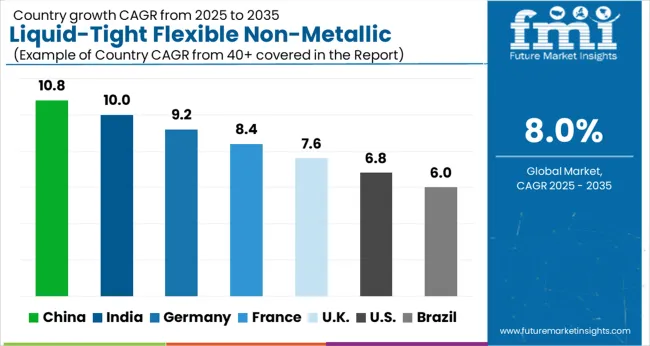
| Countries | CAGR |
|---|---|
| China | 10.8% |
| India | 10.0% |
| Germany | 9.2% |
| France | 8.4% |
| UK | 7.6% |
| USA | 6.8% |
| Brazil | 6.0% |
The market is projected to grow at a CAGR of 10.1% through 2035, supported by increasing demand across commercial, industrial, and infrastructure projects. Among BRICS nations, China has recorded 13.6% growth, driven by large-scale construction and industrial manufacturing, while India has observed 12.6%, supported by rising demand in residential and commercial building projects. In the OECD region, Germany has been measured at 11.6%, where steel production and industrial applications have been steadily expanded. The United Kingdom has been noted at 9.6%, as construction and refurbishment activities have been steadily supplied, and the USA has been recorded at 8.6%, with production for commercial and industrial sectors being consistently increased. This report includes insights on 40+ countries; the top five markets are shown here for reference.
The liquid-tight flexible non-metallic conduit market in China is growing at a CAGR of 10.8%, driven by the country’s rapid industrialization, urbanization, and infrastructure development. These conduits are widely used in protecting electrical wiring systems across residential, commercial, and industrial projects due to their flexibility, moisture resistance, and ease of installation. Rising investments in smart cities, renewable energy projects, and advanced manufacturing facilities further boost demand. The shift toward safer and more efficient electrical infrastructure supports adoption in critical applications like railways, airports, and large-scale construction projects. Additionally, China’s focus on sustainable building practices and modernized energy systems fuels steady market growth. Technological advancements such as conduits with enhanced flame resistance, UV protection, and improved durability are gaining traction. With increasing demand for cost-effective and reliable wiring protection solutions, the market for liquid-tight flexible non-metallic conduits in China is expected to expand consistently.
The liquid-tight flexible non-metallic conduit market in India is expanding at a CAGR of 10.0%, supported by growing industrialization, urban development, and government-backed infrastructure projects. Increasing demand for safe and flexible electrical wiring solutions in construction, transportation, and industrial automation is driving adoption. The rise of smart city projects, renewable energy installations, and electrification of rural areas enhances the use of these conduits. Their properties, including resistance to moisture, oil, and chemicals, make them highly suitable for diverse applications. The growing manufacturing sector and the push for modernization in electrical systems contribute further to market growth. Technological upgrades such as UV-resistant, flame-retardant, and environmentally friendly conduit designs are being increasingly adopted. As India focuses on strengthening its energy infrastructure and improving safety standards in construction, the demand for liquid-tight flexible non-metallic conduits is projected to rise steadily.
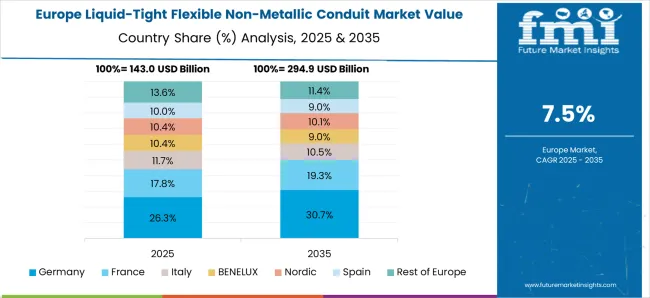
The liquid-tight flexible non-metallic conduit market in Germany is growing at a CAGR of 9.2%, supported by strict building codes, advanced industrial infrastructure, and growing renewable energy projects. The country’s emphasis on safety standards and high-quality construction practices ensures consistent demand for durable and flexible conduits. These products are widely used in protecting electrical wiring in industrial automation, renewable power plants, and modern commercial buildings. Germany’s engineering-driven industries favor conduits with advanced features like UV protection, flame resistance, and long service life. Adoption is also strong in automotive manufacturing and energy-efficient building projects, where electrical wiring safety and flexibility are critical. Furthermore, the European Union’s focus on energy efficiency and sustainable construction practices enhances the market outlook. With rising investments in green infrastructure and smart manufacturing facilities, Germany’s market for liquid-tight flexible non-metallic conduits is expected to remain robust.
The liquid-tight flexible non-metallic conduit market in the United Kingdom is expanding at a CAGR of 7.6%, driven by modernization of electrical systems, infrastructure development, and renewable energy projects. These conduits are widely used in construction, transportation, and utility projects due to their moisture resistance, flexibility, and ease of installation. Rising focus on public safety, compliance with EU regulations, and the transition to sustainable energy solutions support market growth. Adoption is increasing in commercial buildings, industrial facilities, and residential projects where reliable wiring protection is required. Government initiatives to strengthen energy infrastructure and promote green construction further boost demand. Additionally, advancements in conduit design, such as enhanced UV resistance and flame-retardant properties, are improving reliability and performance. As the UK continues investing in modernization and sustainable development, the liquid-tight flexible non-metallic conduit market is poised for steady expansion.
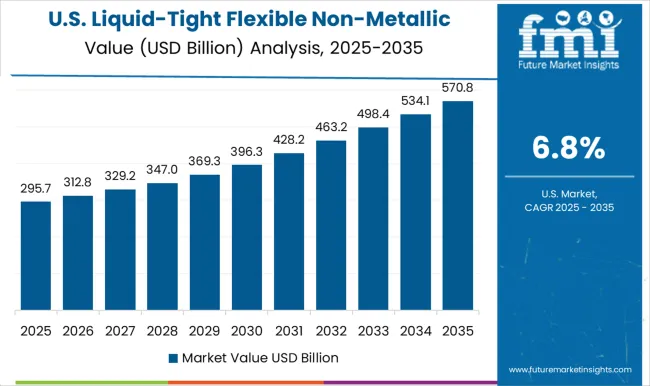
The liquid-tight flexible non-metallic conduit market in the United States is growing at a CAGR of 6.8%, supported by industrial growth, construction modernization, and increased safety regulations. These conduits are extensively used to protect electrical wiring in residential, commercial, and industrial projects due to their flexibility, moisture resistance, and cost-effectiveness. Growing demand in renewable energy projects, transportation systems, and data centers further supports adoption. The USA construction sector’s focus on safety compliance and energy-efficient buildings also enhances the market outlook. Manufacturers are introducing advanced conduit designs with improved durability, UV resistance, and flame-retardant properties to meet evolving industry standards. In addition, industrial automation and smart infrastructure initiatives drive steady demand. With consistent investments in infrastructure, renewable energy, and safety upgrades, the USA market for liquid-tight flexible non-metallic conduits is expected to continue expanding.

The liquid-tight flexible non-metallic conduit market plays a critical role in safeguarding electrical wiring across residential, commercial, and industrial settings. These conduits are widely used for their durability, moisture resistance, and flexibility, making them ideal for environments exposed to water, oil, or corrosive materials. Leading suppliers and manufacturers are continuously innovating in material strength, installation efficiency, and compliance with global safety standards.
ABB and its subsidiary Thomas & Betts Corporation are key players offering reliable conduit systems designed to meet demanding electrical safety requirements. Anamet Electrical, Inc. specializes in flexible conduit solutions engineered for harsh and industrial environments. Atkore provides a broad portfolio of conduits, emphasizing long-lasting performance and ease of installation. Champion Fiberglass, Inc. is recognized for its corrosion-resistant fiberglass conduit systems, providing lightweight yet durable alternatives. Dura-Line Corporation manufactures advanced conduit products that prioritize sustainability and efficiency during installation. Eaton delivers innovative electrical protection solutions, including liquid-tight conduits for critical applications. Electri-Flex Company is a well-recognized leader in flexible conduits, offering extensive product lines tailored for diverse industries. Hubbell and Legrand provide high-quality conduit systems, supporting large-scale electrical infrastructure projects worldwide. IPEX USA LLC. Specializes in thermoplastic conduit solutions with strong chemical and moisture resistance. Kaiphone Technology Co., Ltd. provides cost-effective, durable conduit solutions catering to global markets. Southwire Company, LLC, is another major player, delivering high-performance conduit products that are integrated into broader electrical distribution systems.
| Item | Value |
|---|---|
| Quantitative Units | USD 585.3 Billion |
| Trade Size | ½ to 1, 1 ¼ to 2, 2 ½ to 3, 3 to 4, 5 to 6, and Others |
| Application | Rail infrastructure, Military aerospace, Healthcare facilities, Process plants, Energy, and Others |
| End Use | Residential, Commercial, Industrial, and Utility |
| Regions Covered | North America, Europe, Asia-Pacific, Latin America, Middle East & Africa |
| Country Covered | United States, Canada, Germany, France, United Kingdom, China, Japan, India, Brazil, South Africa |
| Key Companies Profiled | ABB, Anamet Electrical, Inc., Atkore, Champion Fiberglass, Inc., Dura-Line Corporation, Eaton, Electri-Flex Company, Hubbell, IPEX USA LLC., Kaiphone Technology Co. Ltd., Legrand, Southwire Company, LLC., and Thomas & Betts Corporation |
| Additional Attributes | Dollar sales vary by trade size, such as ½–1 in., 1¼–2 in., and 2½–3 in. conduits; by application, spanning industrial, commercial, energy, rail infrastructure, military aerospace, healthcare, and process plants; by region, led by Asia-Pacific, with strong North America and Europe contributions. Growth is driven by corrosion resistance, lightweight installation, safety standards, hybrid materials, and hygienic innovations. |
The global liquid-tight flexible non-metallic conduit market is estimated to be valued at USD 585.3 billion in 2025.
The market size for the liquid-tight flexible non-metallic conduit market is projected to reach USD 1,263.6 billion by 2035.
The liquid-tight flexible non-metallic conduit market is expected to grow at a 8.0% CAGR between 2025 and 2035.
The key product types in liquid-tight flexible non-metallic conduit market are ½ to 1, 1 ¼ to 2, 2 ½ to 3, 3 to 4, 5 to 6 and others.
In terms of application, rail infrastructure segment to command 33.7% share in the liquid-tight flexible non-metallic conduit market in 2025.






Our Research Products

The "Full Research Suite" delivers actionable market intel, deep dives on markets or technologies, so clients act faster, cut risk, and unlock growth.

The Leaderboard benchmarks and ranks top vendors, classifying them as Established Leaders, Leading Challengers, or Disruptors & Challengers.

Locates where complements amplify value and substitutes erode it, forecasting net impact by horizon

We deliver granular, decision-grade intel: market sizing, 5-year forecasts, pricing, adoption, usage, revenue, and operational KPIs—plus competitor tracking, regulation, and value chains—across 60 countries broadly.

Spot the shifts before they hit your P&L. We track inflection points, adoption curves, pricing moves, and ecosystem plays to show where demand is heading, why it is changing, and what to do next across high-growth markets and disruptive tech

Real-time reads of user behavior. We track shifting priorities, perceptions of today’s and next-gen services, and provider experience, then pace how fast tech moves from trial to adoption, blending buyer, consumer, and channel inputs with social signals (#WhySwitch, #UX).

Partner with our analyst team to build a custom report designed around your business priorities. From analysing market trends to assessing competitors or crafting bespoke datasets, we tailor insights to your needs.
Supplier Intelligence
Discovery & Profiling
Capacity & Footprint
Performance & Risk
Compliance & Governance
Commercial Readiness
Who Supplies Whom
Scorecards & Shortlists
Playbooks & Docs
Category Intelligence
Definition & Scope
Demand & Use Cases
Cost Drivers
Market Structure
Supply Chain Map
Trade & Policy
Operating Norms
Deliverables
Buyer Intelligence
Account Basics
Spend & Scope
Procurement Model
Vendor Requirements
Terms & Policies
Entry Strategy
Pain Points & Triggers
Outputs
Pricing Analysis
Benchmarks
Trends
Should-Cost
Indexation
Landed Cost
Commercial Terms
Deliverables
Brand Analysis
Positioning & Value Prop
Share & Presence
Customer Evidence
Go-to-Market
Digital & Reputation
Compliance & Trust
KPIs & Gaps
Outputs
Full Research Suite comprises of:
Market outlook & trends analysis
Interviews & case studies
Strategic recommendations
Vendor profiles & capabilities analysis
5-year forecasts
8 regions and 60+ country-level data splits
Market segment data splits
12 months of continuous data updates
DELIVERED AS:
PDF EXCEL ONLINE
Flexible Metallic Conduit Market Size and Share Forecast Outlook 2025 to 2035
Flexible Electrical Conduit Market Size and Share Forecast Outlook 2025 to 2035
Liquid-Tight Flexible Metal Conduit Market Size and Share Forecast Outlook 2025 to 2035
Commercial Flexible Electrical Conduit Market Size and Share Forecast Outlook 2025 to 2035
Utility-Scale Flexible Electrical Conduit Market Size and Share Forecast Outlook 2025 to 2035
Commercial Liquid-Tight Flexible Non-Metallic Conduit Market Size and Share Forecast Outlook 2025 to 2035
Flexible Packaging Paper Market Size and Share Forecast Outlook 2025 to 2035
Flexible Plastic Pouch Market Size and Share Forecast Outlook 2025 to 2035
Flexible Plastic Packaging Market Size and Share Forecast Outlook 2025 to 2035
Flexible Rubber Sheets Market Size and Share Forecast Outlook 2025 to 2035
Nonmetallic Mineral Product Market Size and Share Forecast Outlook 2025 to 2035
Flexible Printed Circuit Boards Market Size and Share Forecast Outlook 2025 to 2035
Flexible Packaging Machinery Market Size and Share Forecast Outlook 2025 to 2035
Flexible Electronic Market Size and Share Forecast Outlook 2025 to 2035
Flexible Foam Market Size and Share Forecast Outlook 2025 to 2035
Flexible Plastic Packaging Industry Analysis in United States Size and Share Forecast Outlook 2025 to 2035
Flexible Protective Packaging Market Size and Share Forecast Outlook 2025 to 2035
Flexible AC Current Transmission System Market Size and Share Forecast Outlook 2025 to 2035
Flexible End-Load Cartoner Market Size and Share Forecast Outlook 2025 to 2035
Flexible Packaging Market Size and Share Forecast Outlook 2025 to 2035

Thank you!
You will receive an email from our Business Development Manager. Please be sure to check your SPAM/JUNK folder too.
Chat With
MaRIA